Bounty Island Tobago
Palm beaches and a lush green inland
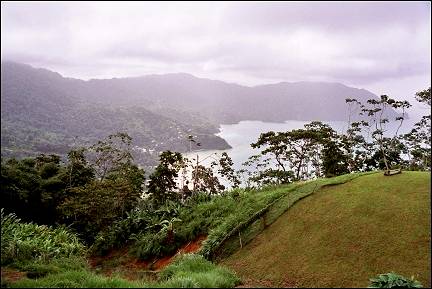
|
Tobago is a small island. Still you should take time to explore it, because the winding roads over the steep hills in the green inland are rather bad. But driving slowly has the advantage you see a lot. Tobagans just park their cars in the middle of the road to talk to someone they see. Everything is accompanied by the twittering of many birds and the murmuring of the sea.
Travelogue & photos: Geja Rijsman
Tobago is a small island, measuring 42 by 10 kilometers, off the Venezuelan northeast coast. It forms a unity with Trinidad. Both islands were British colonies and that is still noticeable: traffic keeps to the left and the electoral system is exactly like the one in Britain (districts).
Long ago Tobago was part of the South-American continent, which accounts for its varied flora and wildlife. The island is best known for its wonderful nature, it has the oldest protected rain forest in the world, the most beautiful birds (210 species) and scooby diving locations. There are snakes, but no poisonous ones. And that makes hiking so much more relaxing.
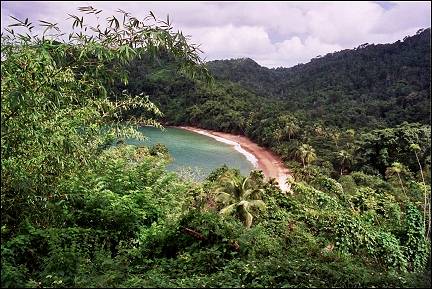
|
Usually January is the dry season, with only a few short tropical showers. Unfortunately the weather is atypical and we get a lot of rain. But the island is worth it.
During over stopover on Isla Margarita we are submitted to the most bizarre security check we ever had. After the transit hall, everyone is extensively searched and all carry-on luggage is opened on long tables. This seems to be routine and is required by the Venezolean authorities.
Rex Turtle Beach, west
The steep hills in the inland are hardly inhabited
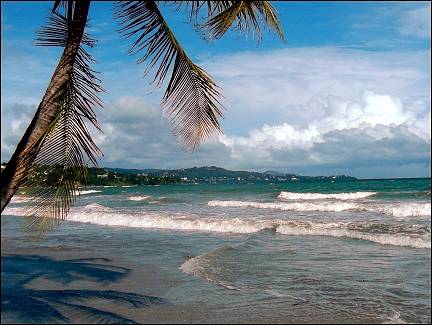
|
When we land on Tobago in the evening, it's still 27 degrees centigrade. We take a cab to our hotel on Rex Turtle Beach. There are hardly any streetlights and we don't see many traffic signs either.
The next morning we find out that there was a tropical rainstorm last night. The hotel garden is filled with twittering of many beautiful birds who fly around and sit in a tree opposite us. One of them is a very pretty little blue bird.
After our rental car is delivered, we leave immediately to explore the surroundings. First we drive to Crown Point, the western tip of the island, where the airport is, then by way of Buccoo Bay and Pidgeon Point on the north coast to the south, to Scarborough.
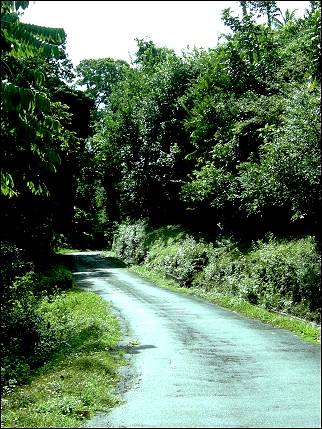
|
Scarborough is the island's capital. It looks actually more like a village. It's not an inviting place and we leave quickly.
We drive through the hilly and lush green inland from Patients Hill on a narrow road back north.
The only sounds we hear in the green, hilly inland, are bird songs. Because the hills are steep in the inland, hardly anyone lives here. Building is only feasable in the coastal area.
At Black Rock is a restaurant about which we read enthusiastic reviews on the internet. We have lunch outside with a view of the sea.
The sun is shining again and we drive a little more: Arnos Vale Road with a large watermill in a bird sanctuary. There used to be sugarcane plantations here, but they were destroyed in a 1963 hurricane.
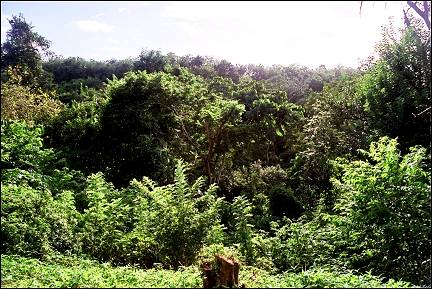
|
After the destruction of her plantation the owner started to feed birds and she still does. Every day at 4 PM, even though nowadays it's mainly for the tourists. The surroundings are densely overgrown.
The next day the weather is unstable. Sometimes the sun shines, at other moments there are showers. But it's still nice and warm.
We lazy away the morning on the beach, in the shade of palmtrees, with each a book, in the company of three dogs who want to be petted. In our hotel room is a brochure that warns us that these "wild animals" are not to be trusted. But they're not wild and are in a hurry to get near you, wagging their tails.
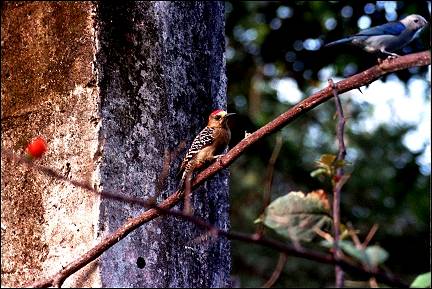
|
In the afternoon we drive to the bird sanctuary. First we visit the old sugercane plantation, Arnos Vale, with its large watermill. It has a beautiful garden, but few paths, so we drive on to Grafton Bird Sanctuary, located on an old cocoa plantation.
This plantation was also made into a bird sanctuary by its owners after the 1963 hurricane. This one has more paths and the surroundings are pretty and tropically lush. The birds are fed at 4 PM, which makes it possible to get a good look at them. All kinds of birds appear, from large ones to diminutive hummingbirds, from grey to brightly colored.
We see many kinds of hummingbird, stunning blue and rusty-brown. We also see a Mot-Mot, Tobago's special bird. It's a beautiful animal with a blue head, rusty-brown chest and blue-green back and tail.
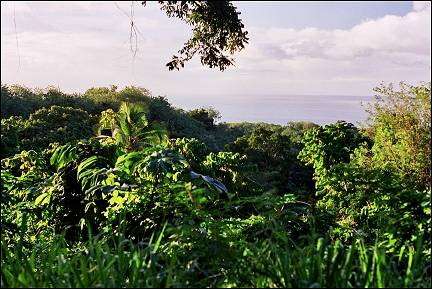
|
We walk for an hour with a guide who knows a lot more about birds than we do and who tells us their names and habits. Fortunately there few tourists at the moment, so we can wander around and talk with him.
In the evening we have dinner in the same restaurant where we had lunch yesterday. Not outside, because it rains, but on the open upper floor. We have a delicious shrimp and coconut curry. A steelband plays music.
Speyside, east
Our background music is the twittering of many birds
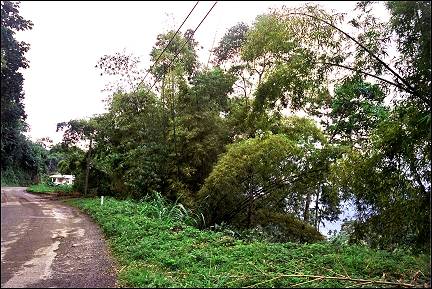
|
Today we move to Speyside, the eastern part of the island. We chose to stay on the two farthest ends of the island, because the bad roads make it impossible to cover large distances on day trips.
The next morning we are reading on the beach when Lorna, the "beach massage lady", approaches us. We don't need a massage, but we like a friendly chat.
Then we drive to Speyside in three hours, criss-cross over the island. It's only 42 kilometers long, but the roads wind over the mountains and also have many potholes, which means you won't go faster than 30 k/p/h on average.
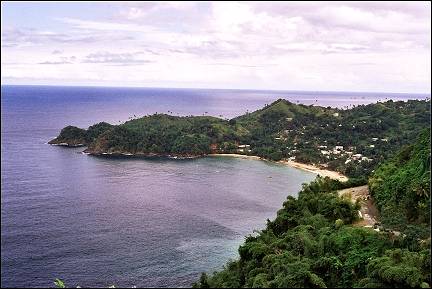
|
But, on the upside: this allows you to get a good look at everything. Tobagans stop their cars in the middle of the road if they want to chat with someone they meet and everyone else calmly drives around them. Which is a good thing to know if you want to take pictures...
It's really hilly with every now and then views of bays with sand beaches far below us.
The last part of our route takes us along the north coast, along English Bay and Bloody Bay. According to legend, the English and the French fought such a hard battle here that the sea colored red. Hence the bay's name.
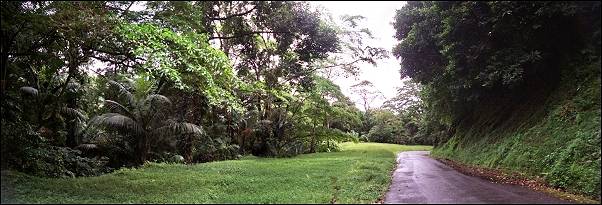
We drive on, over Rain Forest Ridge to Roxburough and there we turn north to our destination. Our hotel is outside the village, on a beach lined with seagrape trees. The atmosphere is wonderfully laid back.
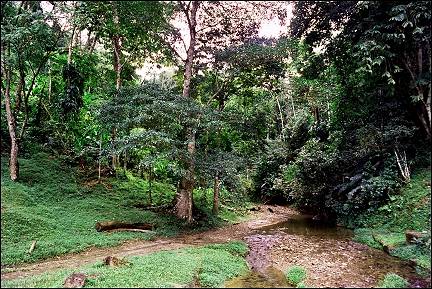
|
On the way to the village to have lunch we give a ride to a guy who turns out to be a diving instructor. The sea water is turbid with mud that the rains brought from the mountains during the rainy season and there isn't much to see when you go diving or snorkeling.
Near the shore the water is brown and muddy. He says "Girl, it's like the Amazone river: you can't see nothing." When you're standing on a hill you can clearly see the difference in color of the sea.
The excessive rain caused more problems than just not this: landslides which have damaged roads, some are even partly washed away. The roads on this side of the island were even completely closed for a while. Our hotel, which sits a the foot of a mountain was partly covered in mud last November.
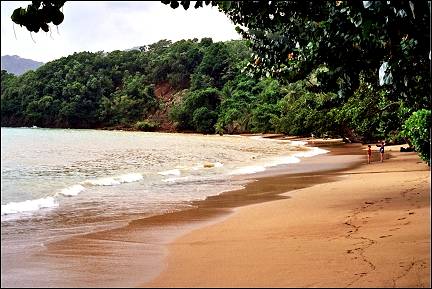
|
Jenna's Tree House, where we have lunch late in the afternoon, is built around and partly in an almond tree. When you sit inside, it feels as if you're sitting in the tree.
The reception is somewhat surly, but it gets beter later. It's remarkable anyway, how people here are less spontaneous and friendly than they are in Jamaica. Our background music is again birds' twitter from the seagrape tree and the murmuring of the waves.
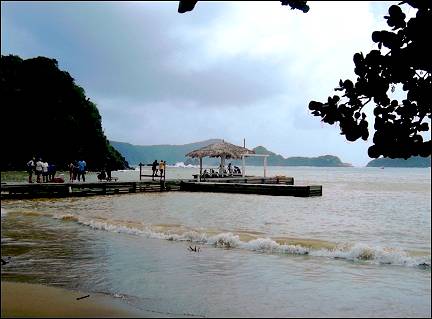
|
Our first breakfast here consists of pancakes; bold little birds with yellow tummies - bananaquits - come and sit on the edge of your plate to eat the leftovers. The tropical rainstorm lasts all day.
Between the worst showers we drive to Charlotteville, a fishers village a little north of our hotel, but because of the rain we don't get much of a view. On the way we see another landslide. Parts of the road are undermined by the rain and have sunk. Bulldozers are busy to remove the mud and fences are being put in place.
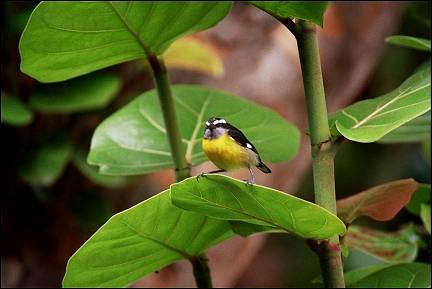
|
The next day begins again with a huge shower, but later in the day it gets better. We explore the south part of the island. First we want to visit Argyle waterfalls, but when we get there, we are discouraged to continue on.
The rain has turned the place into one big pool of mud, through which you have to wade for half an hour to reach the waterfall, which itself has become a "mudfall".
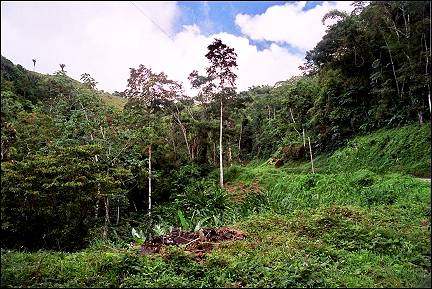
|
We drive west along the south coast to half-way the island and then cross to the north coast. The landscape is again very pretty and lush.
On the way we are happy with our four-wheel drive with its large wheels when we encounter a stretch of road that is covered in a thick layer of mud. We can feel the tyres slipping.
Gilpin Trail has also become a mudbath. There are some top boots for the most courageous hikers, but even the guide doesn't seem eager. We decide to skip rainforest walks during this vacation.
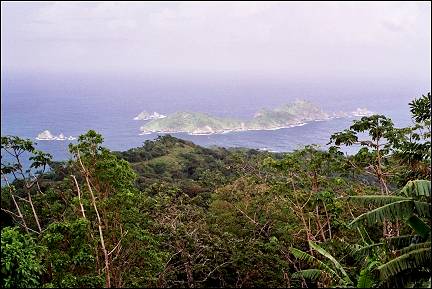
|
At Speyside we drive to a panoramic viewpoint over Charlotteville; now that it's dry the view is much better.
In Speyside we buy delicious hot chicken rotis at a food stall for lunch. It's deliciously spicy West-Indian food and we have guava-pineapple juice to go with it.
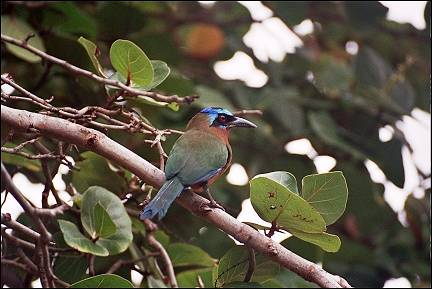
|
Back in our hotel we see a Mot-Mot in the seagrape tree opposite the bar. It sits there for a while, so I get a good picture.
As always there's also a crowd of bananaquits which are easy to lure to your table with a little sugar.
It's already our last day on this beautiful island. The sun tries to break through the clouds to say goodbye. A last breakfast, a little reading on our terrace on the sea and then we drive to the airport on the other side of the island. It's mostly dry and we take a pretty route, again criss-cross over the island.